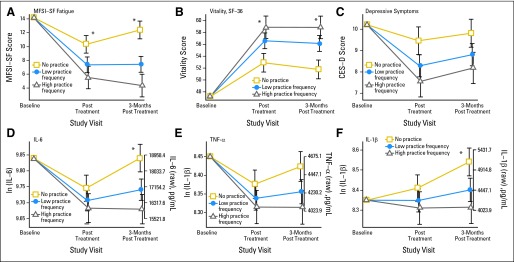Fig 3.

Changes in (A) Multidimensional Fatigue Symptom Inventory–Short Form (MFSI-SF) fatigue scores, (B) vitality scores (36-item short form [SF-36]), (C) depressive symptoms (Center for Epidemiological Studies–Depression [CES-D]), and (D, E, F) lipopolysaccharide-stimulated cytokine production (interleukin-6 [IL-6], tumor necrosis factor alpha [TNF-α], and interleukin-1β [IL-1β]) immediately post treatment and 3 months post treatment as a function of yoga practice frequency. Results shown are mean ± SE from mixed models adjusting for baseline levels, age, and sagittal abdominal diameter at yoga practice frequency levels of 0 minutes per day (control, no practice), 18 minutes per day (25th percentile; low practice), and 29 minutes per day (75th percentile; high practice). (*) P < .05 for the slope estimate in yoga practice frequency. ln, natural log.
